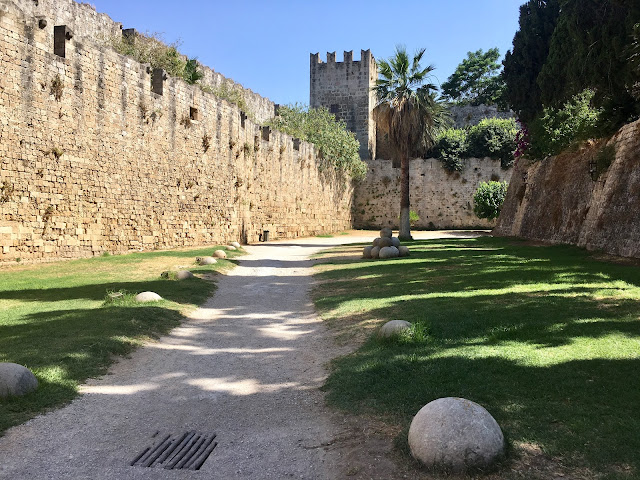Papa and I flew from Bari, Italy, to Rhodes, Greece, late last night. We rented a small apartment in the Old Town of the City of Rhodes. The owner met us at 1 a.m., outside the city walls, to guide us to the apartment. We slept in this morning, and took it easy for much of the day. We were in Rhodes in May 2007, on a sailboat charter trip, and enjoyed it so much that we put it on our “return list.” Here we are!
Historically, Rhodes was famous for the Colossus of Rhodes, one of the Seven Wonders of the Ancient World. The Medieval Old Town of the City of Rhodes has been declared a UNESCO World Heritage Site. Rhodes has been inhabited since the Stone Age, first by Cretans, then Phoenicians prior to the Trojan War in 1184 BC. Rhodes became an ally of Rome from 2000 BC, but from the 1st century BC, it began a slow decline. In 515 AD, the City of Rhodes was destroyed by an earthquake. During the Persian Wars, it was captured by the Persians in 620 AD. In the 11th century, there was a renaissance of commercial activity. When the Crusaders took over Constantinople in 1204, the leader declared himself ruler of Rhodes. In 1261, Byzantine emperors took back Constantinople from the Crusaders. The island was sold to the Knights of St. John in 1309. They left imposing evidence of their presence, with the walled Old Town of Rhodes and its palaces. The Knights stay lasted 213 years, until 1522, when they surrendered the island to Suleiman the Magnificent. The knights found a new home in Malta, where they became known as the Knights of Malta. The Turks remained on the island until 1912, when it was taken over by the Italians. After the end of WWII, Rhodes, along with the other Dodecanese Islands was incorporated within Greece.
We walked about the Old Town today, went to a fresh produce market, ate lunch and dinner out, and strolled about after sunset, enjoying the extraordinary medieval architecture, set on the Mediterranean, with a beautiful harbor setting of windmills and the Old Town Castle. We had a wonderful day!
Historically, Rhodes was famous for the Colossus of Rhodes, one of the Seven Wonders of the Ancient World. The Medieval Old Town of the City of Rhodes has been declared a UNESCO World Heritage Site. Rhodes has been inhabited since the Stone Age, first by Cretans, then Phoenicians prior to the Trojan War in 1184 BC. Rhodes became an ally of Rome from 2000 BC, but from the 1st century BC, it began a slow decline. In 515 AD, the City of Rhodes was destroyed by an earthquake. During the Persian Wars, it was captured by the Persians in 620 AD. In the 11th century, there was a renaissance of commercial activity. When the Crusaders took over Constantinople in 1204, the leader declared himself ruler of Rhodes. In 1261, Byzantine emperors took back Constantinople from the Crusaders. The island was sold to the Knights of St. John in 1309. They left imposing evidence of their presence, with the walled Old Town of Rhodes and its palaces. The Knights stay lasted 213 years, until 1522, when they surrendered the island to Suleiman the Magnificent. The knights found a new home in Malta, where they became known as the Knights of Malta. The Turks remained on the island until 1912, when it was taken over by the Italians. After the end of WWII, Rhodes, along with the other Dodecanese Islands was incorporated within Greece.
We walked about the Old Town today, went to a fresh produce market, ate lunch and dinner out, and strolled about after sunset, enjoying the extraordinary medieval architecture, set on the Mediterranean, with a beautiful harbor setting of windmills and the Old Town Castle. We had a wonderful day!












